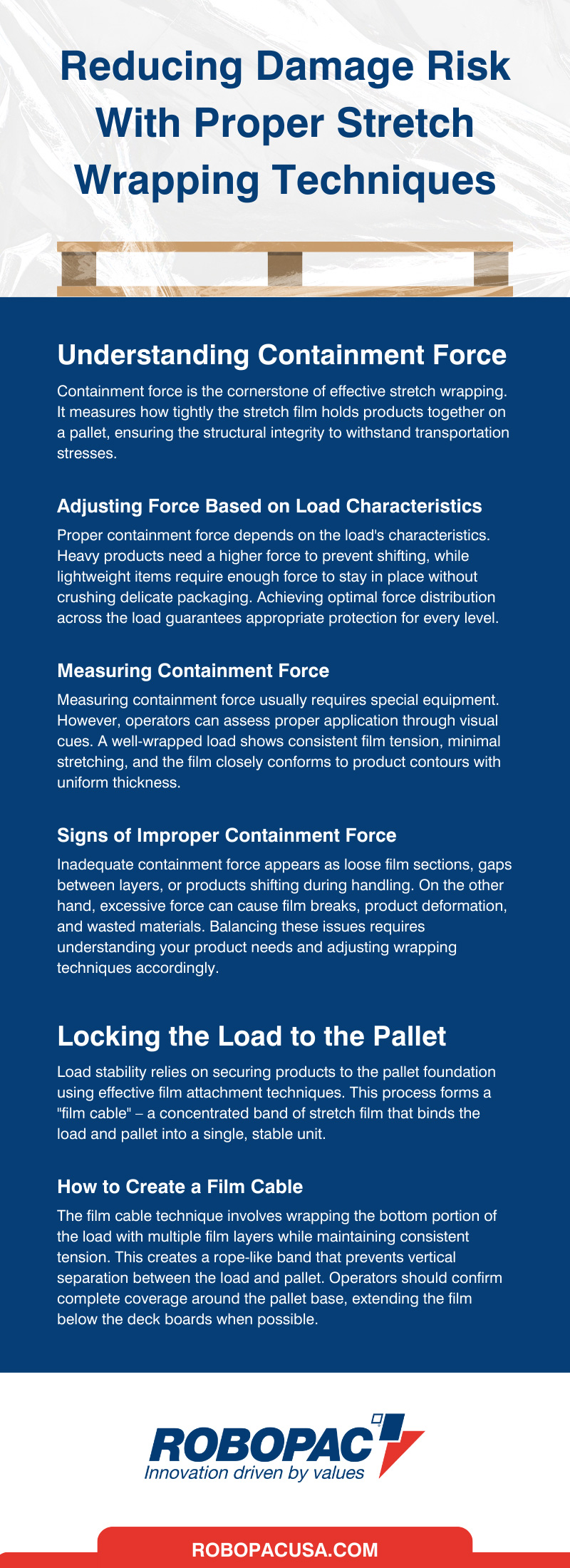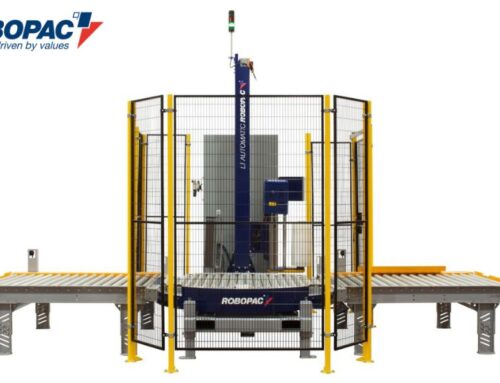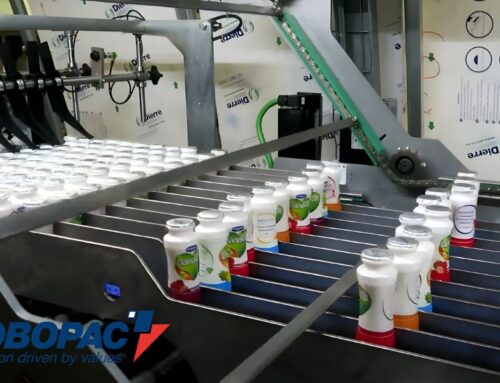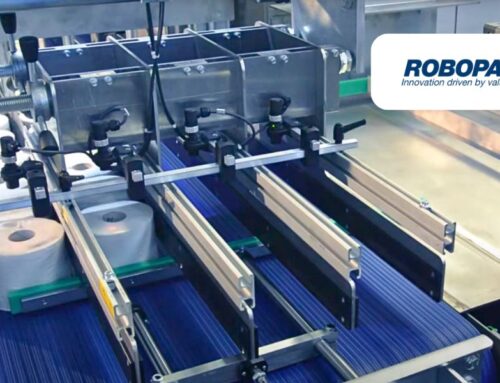Product damage during transit costs businesses billions annually, and one of the frequent causes of such damage is improper stretch wrapping practices. While stretch wrapping can protect goods, ineffective techniques frequently cause more harm than good. The financial impact goes beyond rejected truckloads, with hidden costs such as restacking damaged loads, discounting poorly conditioned merchandise, and losing products that never make it to store shelves.
By mastering the correct and effective stretch wrapping practices, companies can turn this liability into an advantage. In this guide, we’ll explain the proper stretch wrapping techniques and how they can reduce the risk of damage to products in transit.
Understanding Containment Force
Containment force is the cornerstone of effective stretch wrapping. It measures how tightly the stretch film holds products together on a pallet, ensuring the structural integrity to withstand transportation stresses.
Adjusting Force Based on Load Characteristics
Proper containment force depends on the load’s characteristics. Heavy products need a higher force to prevent shifting, while lightweight items require enough force to stay in place without crushing delicate packaging. Achieving optimal force distribution across the load guarantees appropriate protection for every level.
Measuring Containment Force
Measuring containment force usually requires special equipment. However, operators can assess proper application through visual cues. A well-wrapped load shows consistent film tension, minimal stretching, and the film closely conforms to product contours with uniform thickness.
Signs of Improper Containment Force
Inadequate containment force appears as loose film sections, gaps between layers, or products shifting during handling. On the other hand, excessive force can cause film breaks, product deformation, and wasted materials. Balancing these issues requires understanding your product needs and adjusting wrapping techniques accordingly.
Locking the Load to the Pallet
Load stability relies on securing products to the pallet foundation using effective film attachment techniques. This process forms a “film cable” – a concentrated band of stretch film that binds the load and pallet into a single, stable unit.
How to Create a Film Cable
The film cable technique involves wrapping the bottom portion of the load with multiple film layers while maintaining consistent tension. This creates a rope-like band that prevents vertical separation between the load and pallet. Operators should confirm complete coverage around the pallet base, extending the film below the deck boards when possible.
Common Mistakes to Avoid
Errors in film cable formation can compromise load stability. Common mistakes include:
- Starting the wrap too high on the load
- Failing to achieve enough wraps at the base
- Maintaining inconsistent tension during wrapping
These faults weaken the bond between the load and pallet, causing products to shift or separate during handling and transportation.
Adapting to Pallet Condition and Load Composition
Effective film cable creation also depends on the pallet’s condition and the load’s composition. Damaged pallets with nails or broken boards can tear the film, while irregular load profiles may require extra wraps for secure attachment. Operators should assess each load individually and adjust their technique to address specific challenges.
Eliminating Film Tails
One problem that many overlook while stretch wrapping is film tails. Film tails may seem insignificant, but they pose serious risks to product integrity and worker safety. Loose film ends can catch on equipment, tear during handling, and allow moisture and contaminants to reach the product.
Proper Tail Elimination Techniques
Eliminating film tails starts with correct cutting and attachment methods. Operators should focus on cutting the film cleanly to avoid ragged edges that could cause tearing. Pressing the tail firmly against the wrapped surface ensures strong adhesion and prevents separation during handling.
Problems That Long or Dragging Tails Cause
Loose or dragging film tails create numerous issues across the supply chain. They can snag on conveyor systems, causing sudden stops that damage products or injure workers. During transport, these tails may tear parts of the wrap, compromising load stability. In storage, they collect dust and debris and provide entry points for pests.
The Role of Film Selection and Application
Choosing the right film and applying it correctly are key to tail elimination. Films with higher cling properties stick better to wrapped surfaces, reducing tail separation risks. Operators should also factor in environmental conditions like temperature and humidity, as these can impact film adhesion and tail security.
Setting and Maintaining Stretch Wrapping Standards
Establishing comprehensive stretch wrapping standards creates the framework for consistent, effective packaging operations. These standards should address every aspect of the wrapping process, from equipment settings to operator techniques, for reproducible results regardless of shift changes or personnel turnover.
Developing Effective Standards
Effective standards development requires analyzing your specific products, shipping methods, and damage patterns. Companies should document successful wrapping parameters for different product types, creating reference guides that operators can follow consistently. This documentation process helps identify best practices while providing training materials for new employees.
Overcoming Implementation Challenges
Inadequate training and insufficient monitoring may cause implementation challenges. Operators need hands-on instruction in applying standards correctly, along with regular refresher training to maintain proficiency. Management should establish audit procedures to verify compliance and identify areas that require additional training or process improvements.
Adapting to Changing Business Needs
Standards must evolve with changing business conditions, including new products, different packaging materials, and modified shipping requirements. Regular review and update processes safeguard against standards becoming irrelevant or impractical. Companies should also track damage rates and customer feedback to validate standard effectiveness and identify improvement opportunities.
Maintaining Equipment and Operator Performance
The maintenance aspect requires ongoing attention to equipment condition and operator performance. Stretch wrap machines require regular calibration to maintain consistent film application, while operators benefit from periodic skills assessment and additional training when performance gaps emerge.
Benefits of Proper Stretch Wrapping Beyond Damage Reduction
Proper stretch wrapping techniques provide more benefits beyond reducing the risk of product damage in transit. Ideal stretch wrapping creates positive impacts across multiple operational areas. These benefits justify investments in better wrapping practices and equipment upgrades.
Environmental Benefits
Effective stretch wrapping techniques reduce film consumption and enhance load efficiency. Proper stretch wrapping methods achieve superior load stability with less material, minimizing waste and cutting disposal costs. Stable loads also enable higher stacking during transport and storage, improving space utilization and lowering transportation emissions per unit shipped.
Labor Productivity Improvements
Streamlined wrapping processes save time by reducing the need to rewrap damaged loads or address customer complaints about damaged goods. Standardized techniques provide consistency, decreasing training time for new employees and reducing the need for supervisory oversight.
Cost Savings
Cost reductions come from lower material usage, fewer damage claims, and higher customer satisfaction. Many companies find that proper wrapping techniques pay for themselves within months by eliminating waste and avoiding damage-related costs. Better customer relationships mean new business opportunities and stronger supply chain partnerships.
Transforming Your Stretch Wrapping Process With Robopac USA
Effective stretch wrapping is more than a necessity—it’s a strategic advantage. Companies that master proper techniques can protect products, cut costs, and support sustainability efforts. With the right training and process improvements, even existing stretch wrapping equipment can deliver excellent results without costly upgrades.
Leadership plays a vital role in maintaining high standards by providing training, monitoring, and incentives for consistent performance. If you’re ready to improve your stretch wrapping process, contact Robopac USA to learn how our innovative solutions can help your business succeed.








